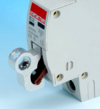Except that I have been advised - as far as I'm concerned by the IET and specifically someone directly involved in maintaining BS7671 - that it can be ignored (i.e. not even mentioned) if it's not in an escape route or under wooden stairs. Needless to say, when pressed, this person was quite happy to repeat the "personal opinion, not official statement by IET, blah, blah".Code 3 (so still satisfactory), for plastic consumer units showing no signs of thermal damage.
Only a Code 2 (unsatisfactory)if signs of thermal damage.
We know very well that the committee know it's a ****-poor regulation. As well as the aforementioned email exchange, I've also flagged it up when drafts of new versions have been out for review. Of course, I'm sure that that manufacturers who are represented on the committee have not allowed the extra sales opportunities of replacing otherwise perfectly acceptable (and often fairly newly installed) CUs to influence them in not correcting the regulation to make sense.
Doubt it. Also, I would imagine there is also no data on whether any of the risks introduced by a conductive metal enclosure have materialised into events.I wonder if, anyone on the regs committee has been monitoring the incidence of CU fires (including LFBs data) since the new reg's introduction?
Given that the (so called) "smart" meter rollout hasn't abated, I would agree with that. Except, there is no requirement for the box to actually control the spread of fire. The only requirement is that the box itself does not combust - there is nothing at all about how it behaves in containing any fire that might start within it. And that makes the regulation even more stupid. You could have a huge hole in the back of the box (common with rear-entry of cables), and if mounted on a stud partition wall, this hole could give a fire direct access to the timber inside the wall, and it's still compliant with the regs. So it doesn't even mandate the protection we all assume the reg is supposed to provide.The number of CU fires would surely be the same, but their spread should have been limited due to the reg change.


